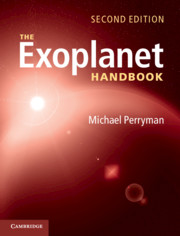Book contents
- Frontmatter
- Contents
- Preface to the Second Edition
- 1 Introduction
- 2 Radial velocities
- 3 Astrometry
- 4 Timing
- 5 Microlensing
- 6 Transits
- 7 Imaging
- 8 Host stars
- 9 Brown dwarfs and free-floating planets
- 10 Formation and evolution
- 11 Interiors and atmospheres
- 12 The solar system
- Appendix A Numerical quantities
- Appendix B Notation and acronyms
- Appendix C Radial velocity exoplanets
- Appendix D Transiting exoplanets
- Appendix E Lensing exoplanets
- Appendix F Imaging exoplanets
- References
- Subject index
- Object index
12 - The solar system
Published online by Cambridge University Press: 25 August 2018
- Frontmatter
- Contents
- Preface to the Second Edition
- 1 Introduction
- 2 Radial velocities
- 3 Astrometry
- 4 Timing
- 5 Microlensing
- 6 Transits
- 7 Imaging
- 8 Host stars
- 9 Brown dwarfs and free-floating planets
- 10 Formation and evolution
- 11 Interiors and atmospheres
- 12 The solar system
- Appendix A Numerical quantities
- Appendix B Notation and acronyms
- Appendix C Radial velocity exoplanets
- Appendix D Transiting exoplanets
- Appendix E Lensing exoplanets
- Appendix F Imaging exoplanets
- References
- Subject index
- Object index
Summary
THEORIES OF THE formation of the solar system have been greatly advanced over the past few decades, in part through a wealth of new and diverse solar system observations from ground and space, including a range of spacecraft fly-bys, orbiters, and landers. These observations have assisted and constrained theories of exoplanet formation and evolution which have, in turn, provided considerable newinsights into the various processes which have controlled the solar system's origin and subsequent evolution.
This chapter provides a selective overview of some of the properties of the solar system, and inferences about its origin and evolution, from the vast range of ongoing research (cf. Table 12.1). It focuses on those topics that may be particularly relevant to exoplanet research.
Amongst them are specific properties of the Sun, the orbital motions of the planets (including spacings, eccentricities, inclinations, dynamical stability, and resonances), planetary masses, rotation, angular momentum and obliquities, the existence and properties of planetary satellites and rings, the origin of Earth's Moon and of water on Earth, the occurrence and dynamical features of other minor bodies (comets, asteroids,meteorites, the Edgeworth–Kuiper belt, the Oort cloud, and zodiacal dust), bulk and isotopic compositions, radiogenic isotope ages, cratering records, and the various disruptive events that may have affected the development of life on Earth.
Over the past decade, the growing appreciation of the possible role of planetary migration in the early solar system has provided a substantial advance in understanding of both its inner and outer populations.
The Sun
A prototype for exoplanet host stars
All exoplanet detection methods are based on some simplified model of the host star. Required models rapidly become more complex: for photometric transit detection, effects such as limb darkening, spin axis orientation, rotation rate, rotational flattening, differential rotation, the presence of star spots, and stellar oscillations are already relevant. For all detection methods, the many manifestations of stellar activity are frequently a potential limiting source of noise.
- Type
- Chapter
- Information
- The Exoplanet Handbook , pp. 649 - 700Publisher: Cambridge University PressPrint publication year: 2018



